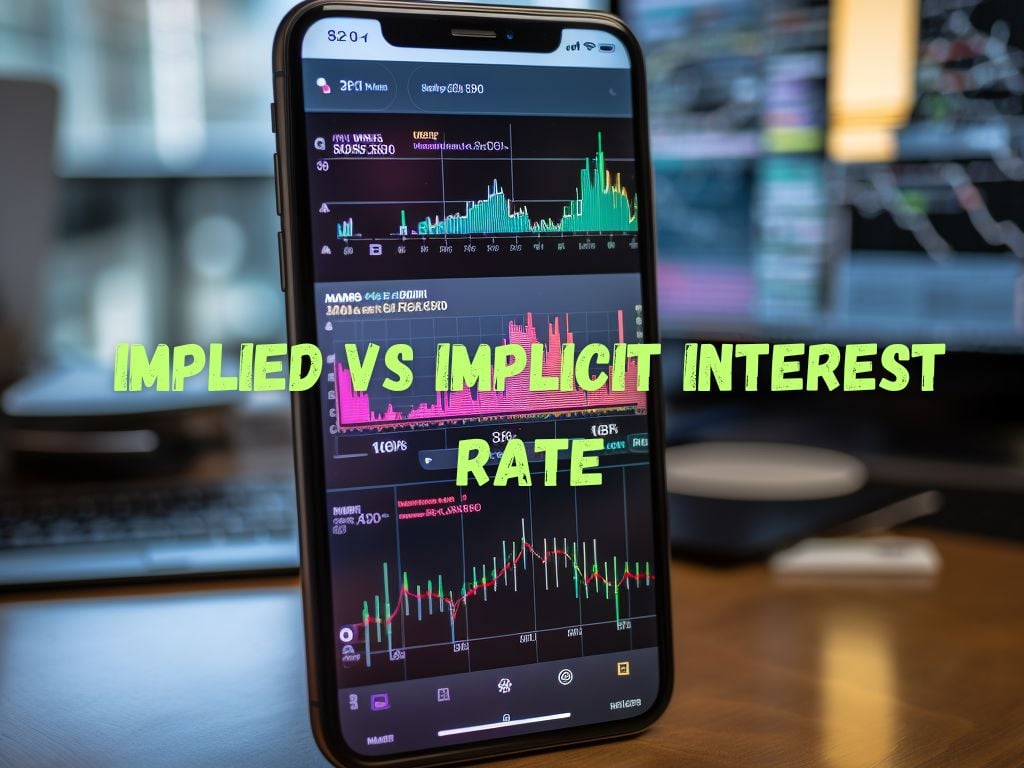Interest rates play a crucial role in the global economy, impacting borrowing costs, investment decisions, and financial markets.
When exploring interest rates, it is essential to understand the distinction between implied and implicit interest rates.
An implied interest rate represents market expectations derived from financial instrument pricing, while an implicit interest rate is embedded within a specific financial transaction or agreement.
This article aims to provide a comprehensive understanding of implied vs implicit interest rate, their calculations, differences, and real-world applications.
Explaining Implied Interest Rate
Implied interest rate refers to the rate of interest derived from the pricing of various financial instruments, such as bonds, options, or loans.
It is considered an expected or anticipated interest rate implied by market pricing. The implied interest rate is not explicitly stated but is calculated based on financial market prices and associated variables.
Calculating the implied interest rate involves analyzing the prices of financial instruments and solving for the interest rate that equates the present value of the expected cash flows with the market prices.

For example, in the bond market, the implied interest rate can be obtained by solving the equation that equates the present value of bond payments (coupon payments and face value) with the market price of the bond. By solving this equation, the implied interest rate is derived.
Factors influencing the implied interest rate include creditworthiness, maturity, liquidity, inflation expectations, supply and demand dynamics of the instrument, and general market conditions.
Changes in any of these factors can lead to fluctuations in the implied interest rate.
Understanding Implicit Interest Rate
Implicit interest rate, on the other hand, refers to the interest rate that is not explicitly stated but is embedded within a financial transaction or agreement. It represents the cost of borrowing or the return on an investment.
The implicit interest rate is commonly associated with time value of money calculations and bond pricing models.
Calculating the implicit interest rate involves determining the rate that equates the present value of future cash flows with the initial investment or borrowing amount.
Various time value of money calculations, such as discounting or compounding, can be used to calculate the implicit interest rate. Additionally, bond pricing models, such as the yield to maturity or spot rate curve, can be employed to derive the implicit interest rate.
Key Differences between Implied and Implicit Interest Rate
Calculation Method
The calculation methods for implied and implicit interest rates differ significantly.
Implied Interest Rate
Implied interest rates are derived by solving equations that equate the market prices of financial instruments with their expected cash flows.
For example, in the bond market, the implied interest rate can be obtained by solving the equation that equates the present value of bond payments (coupon payments and face value) with the market price of the bond.
By solving this equation, the implied interest rate is derived.
Implicit Interest Rate
Implicit interest rates are calculated using time value of money formulas or bond pricing models. These calculations involve discounting or compounding future cash flows to their present value.
Bond pricing models, such as the yield to maturity or spot rate curve, are often employed to derive the implicit interest rate.
Source of Information
The source of information for implied and implicit interest rates varies.
Implied Interest Rate
Implied interest rates are derived from market pricing and reflect the expectations of market participants. They are forward-looking and provide insights into market sentiment and expectations.
Implicit Interest Rate
Implicit interest rates are embedded within a specific financial transaction or agreement. They are not explicitly stated, but can be derived from the terms and conditions of the transaction or by employing suitable calculation methods.
Factors considered in implicit interest rate calculations include the time value of money and bond pricing models.

Interpretation and Implications
The interpretation and implications of implied and implicit interest rates also differ.
Implied Interest Rate
Implied interest rates provide insights into market expectations and investor sentiment. They can be used to gauge market perceptions of risk, creditworthiness, and inflation expectations.
Changes in implied interest rates can indicate shifts in market sentiment, risk appetite, or economic conditions.
Implicit Interest Rate
Implicit interest rates reveal the borrowing costs or investment returns associated with a specific financial instrument or agreement.
They enable individuals and businesses to assess the affordability of loans or the potential return on investments. Implicit interest rates are important factors in determining the overall cost of borrowing and investment feasibility.
Usage and Application
Implied and implicit interest rates find application in different financial contexts.
Implied Interest Rate
Implied interest rates are commonly used in options pricing, bond markets, and other financial instruments. They aid investors and traders in assessing market expectations and making informed decisions.
Implied interest rates can also provide insights into the relative attractiveness of different investment options.
Implicit Interest Rate
Implicit interest rates are crucial in various financial transactions, including loans, leases, and annuities. They help individuals and businesses determine the affordability and cost-effectiveness of borrowing or investing.
Implicit interest rates are often used in cash flow analysis, capital budgeting, and financial planning exercises.
Factors Influencing Implied and Implicit Interest Rates
Implied and implicit interest rates are influenced by a wide range of factors that impact the financial markets and the overall economy.
Here are some key factors to consider:
Economic Factors
Economic factors play a significant role in determining implied and implicit interest rates. These factors include:
- Inflation: Inflation expectations affect both implied and implicit interest rates. Higher inflation expectations can lead to an increase in both rates, as lenders and investors demand higher returns to compensate for the eroding value of money over time.
- Unemployment: The level of unemployment can influence interest rates. Lower unemployment levels generally indicate a stronger economy, leading to higher implied and implicit interest rates.
- Economic Growth: The rate of economic growth affects interest rates. Higher economic growth can result in increased borrowing demand, leading to upward pressure on implied and implicit interest rates.
Government Policies
Government policies, particularly monetary policy decisions and regulatory changes, have a significant impact on implied and implicit interest rates.
Central banks use monetary policy tools, such as adjusting interest rates or implementing quantitative easing measures, to influence overall interest rate levels.
Regulatory changes, such as alterations in lending standards or capital requirements, can also affect interest rates.
Market Conditions
Market conditions play a crucial role in determining implied interest rates. Factors such as liquidity, investor sentiment, and supply and demand dynamics can influence interest rates.
For example, during periods of market stress or a flight to safety, investors may demand higher returns, resulting in increased implied interest rates.
Global Events and Geopolitical Factors
Global events and geopolitical factors can impact implied and implicit interest rates.
Uncertainty, geopolitical tensions, or major events such as elections or geopolitical conflicts can lead to increased risk aversion among investors, resulting in higher implied interest rates as they require a higher return for taking on perceived risks.
Understanding these factors and their interactions is essential to grasp the dynamics of implied and implicit interest rates and make informed decisions in the financial markets.
Economists, policymakers, and market participants closely monitor these factors to anticipate interest rate movements and their impact on the overall economy.

Frequently Asked Questions
How are implied and implicit interest rates calculated?
Implied interest rates are derived by solving equations that equate market prices of financial instruments with expected cash flows. Implicit interest rates are calculated using time value of money formulas or bond pricing models.
Are implied and implicit interest rates always accurate?
Implied and implicit interest rates are estimates based on various factors and market conditions and may not necessarily reflect actual future rates.
How do implied and implicit interest rates affect the economy?
Implied and implicit interest rates influence borrowing costs, investment decisions, and financial market performance. Changes in these rates can impact consumer spending, business investment, and overall economic activity.
Can implied and implicit interest rates be used to predict future market movements?
Implied interest rates provide insights into market expectations but should be interpreted with caution. Implicit interest rates can help assess the costs and returns associated with specific financial instruments but do not predict market movements.
Conclusion
Understanding the difference between implied and implicit interest rates is essential for investors, economists, and individuals involved in financial transactions.
Implied interest rates provide insights into market expectations, while implicit interest rates reveal the borrowing costs or investment returns associated with specific financial instruments or agreements.
By considering various factors and employing appropriate calculation methods, one can gain a comprehensive understanding of these interest rates and navigate the complex world of finance more effectively.


 Tags:
Tags:










